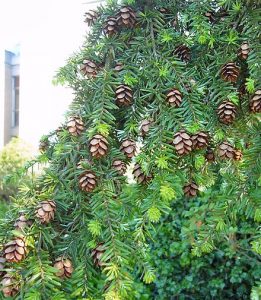Western Hemlock: Tsuga Heterophylla
Seeing a Western Hemlock from a distance, the floppy top is a clue:



A species of hemlock native to the west coast of North America, with its northwestern limit on the Kenai Peninsula, Alaska, and its southeastern limit in northern Sonoma County, California.
Western hemlock is a large evergreen coniferous tree growing to 165–230 ft (50–70 m) tall, exceptionally 273.42 ft (83.34 m), and with a trunk diameter of up to 9 ft (2.7 m). It is the largest species of hemlock, with the next largest (mountain hemlock, T. mertensiana) reaching a maximum of 194 ft (59 m). The bark is brown, thin and furrowed. The crown is a very neat broad conic shape in young trees with a strongly drooping lead shoot, becoming cylindric in older trees; old trees may have no branches in the lowest 100–130 ft (30–40 m). At all ages, it is readily distinguished by the pendulous branchlet tips.
Western hemlock is closely associated with temperate rain forests, and most of its range is less than 100 km (62 mi) from the Pacific Ocean. There is however an inland population in the Columbia Mountains in southeast British Columbia, northern Idaho and western Montana. It mostly grows at low altitudes, from sea level to 600 m (2,000 ft), but up to 1,800 m (5,900 ft) in the interior part of its range in Idaho.
It is a very shade-tolerant tree; among associated species in the Pacific Northwest, it is matched or exceeded in shade tolerance only by Pacific yew and Pacific silver fir. Young plants typically grow up under the canopy of other conifers such as Sitka spruce or Douglas-fir, where they can persist for decades waiting to exploit a gap in the canopy. They eventually replace these conifers, which are relatively shade-intolerant, in climax forest. However, storms and wildfires will create larger openings in the forest where these other species can then regenerate.
Initial growth is slow; one-year-old seedlings are commonly only 3–5 cm (1 1⁄8–2 in) tall, and two-year-old seedlings 10–20 cm (4–8 in) tall. Once established, saplings in full light may have an average growth rate of 50–120 cm (20–47 in) (rarely 140 cm, 55 in) annually until they are 20–30 m (65–100 ft) tall, and in good conditions still 30–40 cm (12–16 in) annually when 40–50 m (130–165 ft) tall. The tallest specimen, 82.83 m (271 ft 9 in) tall, is in Prairie Creek Redwoods State Park, California (United States). It is long-lived, with trees over 1200 years old known.[5]
Western hemlock forms ectomycorrhizal associations with some well-known edible fungi such as chanterelles (Cantharellus formosus, C. subalbidus, and Craterellus tubaeformis). It is capable of associating with wood-decay fungi in addition to soil fungi; this enables its seedlings to survive on rotting stumps and logs.


